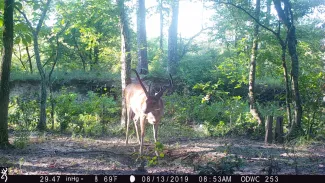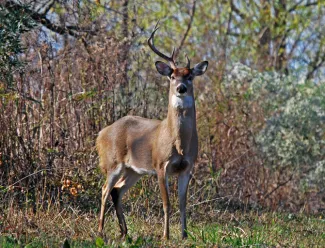For a deer hunter, perhaps nothing brings greater excitement than a “monster” buck drawing near on the opening day of the deer rifle season. On the flip side, nothing may bring more questions and confusion than when that “monster” buck has huge antlers on one side and nothing more than a small spike on the other. What happened? How can this be? Inevitably, the next question we all face is should I harvest it or not?

Photo provided by Dakota Christian.
A “spike-on-one-side” buck is a term that refers to those bucks, especially older deer, which have “normal” antler growth on one side and a spike or other much reduced antler-look on the other. Oftentimes, the “normal” antler has 4, 5 or even more points. Generally, the other antler would look very similar, but something went wrong at some point resulting in the odd look. While many things can cause a large buck to grow weird antlers, injuries are a common cause.
In general, many spike-on-one-side bucks, especially those older than 2.5 years in age, have experienced some type of injury that affected the growth and look of one antler. This can be some type of skeletal injury, like an injury to a hind leg, a cranial injury to the skull or pedicle (frontal bone), or an injury directly to the antler while in velvet.
Head injuries can be quite common and are largely a result of combative sparring. Injuries while in velvet can also lead to weird antler forms, including the much-reduced spike-on-on-side look. Even old gunshot wounds can have an effect on one antler. Strangely, injuries to a hind leg usually affect the antler development on the other side of the body. Thus a right hind leg injury, even one that fully heals, can reduce the antler development on the left side.
It’s important to mention that yearling bucks (those that are 1.5 years old) may have a spike-on-one-side look. They may have spikes on both sides or a spike on one and forked antler on the other. For the most part, they simply haven’t reached their maturity potential yet. Letting young bucks grow is the solution for these younger deer, especially if larger racked deer are desired. Many young spike bucks can and will mature into large racked, and even trophy, deer if given enough time and with the proper nutrition.

The big question biologists often receive is if older spike-on-one-side bucks should be harvested and removed from the breeding population. While the answer to this question can be complex, it often depends on the land manager’s goals and whether he or she is satisfied with the look of the one good antler the spike-on-one-side buck has. In essence, injury-induced antlers are not transferred genetically. Instead, the buck’s “normal” antler provides the blueprint of the genetics it carries. Sometimes, however, the antlers of some mature bucks can remain “small” or “odd” according to a hunter’s or land manager’s standards despite the lack of any injury. These bucks may require some extra thought and attention when deciding whether to harvest them or leave them be.
Deciding to harvest a buck solely due to his spike-on-one-side look can also bring other factors into play. If, after thorough surveying, it is known that the spike-on-one-side buck in question happens to have the best antler-based genetics of those on and nearby the property, it may be best to let him walk to pass on his genes. However, mature bucks often roam far and wide to locate, court, and breed with ready does. As a result, it can be extremely difficult to ever have full knowledge of all the breeding bucks in an area. Remember, too, that does also play a role in the genetic makeup of the offspring.
In short, spike-on-one-side bucks can bring about more questions than answers when they are encountered. Having a little knowledge beforehand can make all the difference when making the decision of whether to let him walk or harvest him for management reasons. If you're not sure whether or not to pull the trigger on a spike buck, instead take or wait for a doe. That is nearly always the best decision you can make for the long term health of the deer herd.